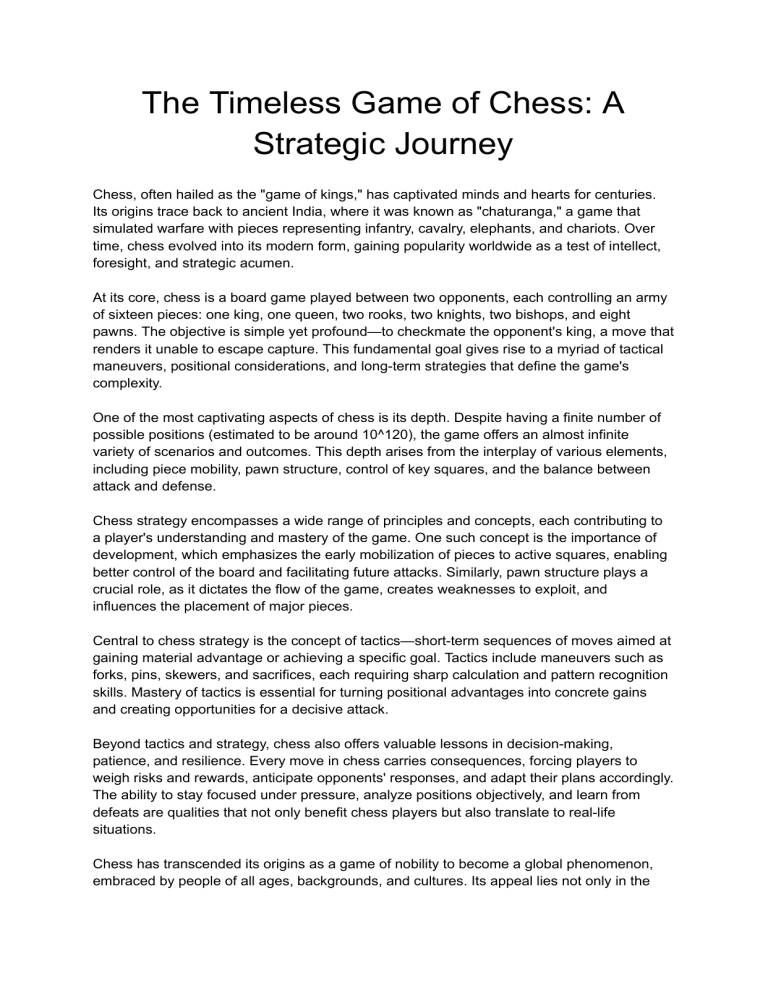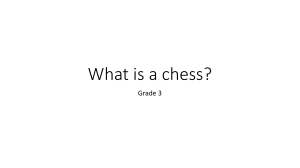
The Timeless Game of Chess: A Strategic Journey Chess, often hailed as the "game of kings," has captivated minds and hearts for centuries. Its origins trace back to ancient India, where it was known as "chaturanga," a game that simulated warfare with pieces representing infantry, cavalry, elephants, and chariots. Over time, chess evolved into its modern form, gaining popularity worldwide as a test of intellect, foresight, and strategic acumen. At its core, chess is a board game played between two opponents, each controlling an army of sixteen pieces: one king, one queen, two rooks, two knights, two bishops, and eight pawns. The objective is simple yet profound—to checkmate the opponent's king, a move that renders it unable to escape capture. This fundamental goal gives rise to a myriad of tactical maneuvers, positional considerations, and long-term strategies that define the game's complexity. One of the most captivating aspects of chess is its depth. Despite having a finite number of possible positions (estimated to be around 10^120), the game offers an almost infinite variety of scenarios and outcomes. This depth arises from the interplay of various elements, including piece mobility, pawn structure, control of key squares, and the balance between attack and defense. Chess strategy encompasses a wide range of principles and concepts, each contributing to a player's understanding and mastery of the game. One such concept is the importance of development, which emphasizes the early mobilization of pieces to active squares, enabling better control of the board and facilitating future attacks. Similarly, pawn structure plays a crucial role, as it dictates the flow of the game, creates weaknesses to exploit, and influences the placement of major pieces. Central to chess strategy is the concept of tactics—short-term sequences of moves aimed at gaining material advantage or achieving a specific goal. Tactics include maneuvers such as forks, pins, skewers, and sacrifices, each requiring sharp calculation and pattern recognition skills. Mastery of tactics is essential for turning positional advantages into concrete gains and creating opportunities for a decisive attack. Beyond tactics and strategy, chess also offers valuable lessons in decision-making, patience, and resilience. Every move in chess carries consequences, forcing players to weigh risks and rewards, anticipate opponents' responses, and adapt their plans accordingly. The ability to stay focused under pressure, analyze positions objectively, and learn from defeats are qualities that not only benefit chess players but also translate to real-life situations. Chess has transcended its origins as a game of nobility to become a global phenomenon, embraced by people of all ages, backgrounds, and cultures. Its appeal lies not only in the intellectual challenge it presents but also in the camaraderie it fosters, as players engage in friendly competition, exchange ideas, and share their passion for the game. In recent years, chess has experienced a resurgence in popularity, fueled in part by online platforms that enable players to compete, learn, and connect with others around the world. The rise of chess influencers, streaming channels, and educational resources has further democratized access to the game, making it more inclusive and accessible than ever before. As we reflect on the enduring allure of chess, we recognize it not just as a game but as a timeless pursuit of excellence, creativity, and strategic thinking. Whether played casually for enjoyment or pursued at a professional level, chess continues to inspire and challenge generations, leaving an indelible mark on the fabric of human culture.

